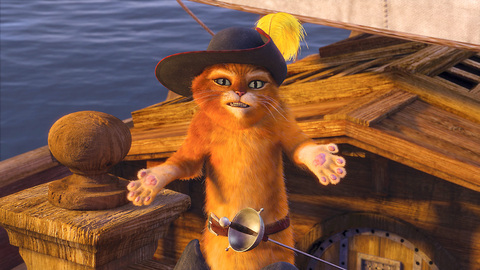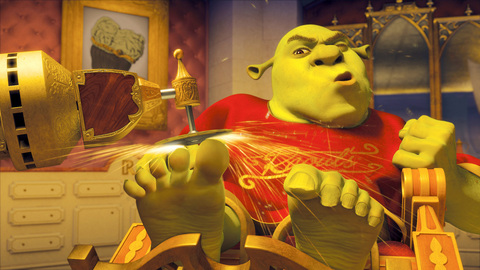For all I know, there may be an endless supply of Shrek sequels in the pipeline. That DreamWorks ogre's skin is the color of money after all. But there is nonetheless a feeling of finality about Shrek the Third, a sense that the tale has at last reached a state of completion. In the first movie Shrek (voiced by Mike Myers) met and wooed his lady love, Fiona (Cameron Diaz); in the second he got to know the in-laws. The current installment finds him faced with impending fatherhood and something of a career crisis. Will he take over his father-in-law's business or remain true to his vocation of bellowing and smashing things?
Unless the Shrek team wants to follow its hero into the dangerous swamps of mid-life, thus shifting his literary pedigree away from William Steig and in the direction of John Updike or Philip Roth, it may want to leave him in a condition of more-or-less happily ever after. Which is only to say that Shrek the Third, directed by Chris Miller and Raman Hui from a script with a half-dozen credited begetters, already feels less like a children's movie than either of its predecessors. (This may be why I liked it better than the others. But then again, so did my kids.)
It isn't that there's anything inappropriate — no smoking or swearing and only the sex implied by Fiona's pregnancy and the brood of Donkey-Dragon offspring — but rather that the movie's liveliest humor and sharpest drama take root in decidedly grown-up situations. Shrek's anxious, less-than-overjoyed reaction to the prospect of becoming a parent is not something most youngsters will relate to. (In one brilliantly executed sequence he has a nightmare of being besieged by hundreds of gurgling, saucer-eyed ogre babies.) And the depiction of Cinderella (Amy Sedaris), Rapunzel (Maya Rudolph) and Snow White (Amy Poehler) as bored, catty moms is likely to tickle fans of Little Children, a group that I hope doesn't include any actual little children.

PHOTOS: UIP
Whether these bits would seem as fresh or incisive if they were not embedded in a noisy cartoon remotely based on a beloved picture book is an open question. The strategy of the Shrek movies has always been to appeal to the easy, smirky cynicism of the parents while whetting their children's appetite for crude humor and plush merchandise. Shrek 2 pulled off the trick in a way that struck me as coarse and overdone, turning travestied fairy tales into the stuff of hackneyed Hollywood satire. But Shrek the Third seems at once more energetic and more relaxed, less desperate to prove its cleverness and therefore to some extent smarter.
It helps that the animation looks better than ever. Practice, along with advances in technology, has made the faces of the characters more expressive and their movements more graceful. The drawn-out death of Fiona's father, a royal frog voiced by John Cleese, is a minor tour de force of pathos and slapstick, and there are some angry trees that do justice to the venerable cinematic tradition of angry trees. Another high point is when Puss in Boots (Antonio Banderas) gets wet.
As for plot, there are several, and also the usual complement of celebrity voices and peppy pop songs. The death of the king leaves Shrek as the reluctant heir to the throne, and the ogre sails off to find a replacement in the person of Artie, a prep-school bully magnet with the voice of Justin Timberlake. Meanwhile the disgraced Prince Charming (Rupert Everett), exiled to a career in dinner theater, organizes a rebellion of fairy-tale villains. Eric Idle plays Merlin as a hippy druid, and Larry King and Regis Philbin do fine work as ugly stepsisters. And of course Eddie Murphy is the indispensable Donkey.

If I sound a bit disenchanted, that may be because disenchantment has been the point of the Shrek movies all along. Expressing a sometimes explicit animus against the Disney versions of well-known European folk tales, the franchise set out from the start to scramble the traditional polarities of good and evil, setting itself up as a more sophisticated, knowing brand of pop-culture magic. But those old stories — and those classic Disney movies — were almost more complicated than the parodies allowed. Their eerie subtexts and haunting ambiguities have always been more crucial to their power and appeal than the overt lessons they teach.
Shrek, Shrek 2 and Shrek the Third, by contrast, are flat and simple, hectic and amusing without being especially thrilling or complex. Their naughty insouciance makes their inevitable lapses into sentimental moralism all the more glaring. In this movie we hear some speeches about how it's important not to care about what other people think of you, and to be yourself above all. Yeah, fine, whatever. This doesn't strike me as necessarily good advice, and in any case today's wised-up kids don't need life lessons from an ogre. But then again, the kids are not the ones who identify with Shrek as he makes his grouchy way through the life cycle.

In the March 9 edition of the Taipei Times a piece by Ninon Godefroy ran with the headine “The quiet, gentle rhythm of Taiwan.” It started with the line “Taiwan is a small, humble place. There is no Eiffel Tower, no pyramids — no singular attraction that draws the world’s attention.” I laughed out loud at that. This was out of no disrespect for the author or the piece, which made some interesting analogies and good points about how both Din Tai Fung’s and Taiwan Semiconductor Manufacturing Co’s (TSMC, 台積電) meticulous attention to detail and quality are not quite up to

April 21 to April 27 Hsieh Er’s (謝娥) political fortunes were rising fast after she got out of jail and joined the Chinese Nationalist Party (KMT) in December 1945. Not only did she hold key positions in various committees, she was elected the only woman on the Taipei City Council and headed to Nanjing in 1946 as the sole Taiwanese female representative to the National Constituent Assembly. With the support of first lady Soong May-ling (宋美齡), she started the Taipei Women’s Association and Taiwan Provincial Women’s Association, where she

Chinese Nationalist Party (KMT) Chairman Eric Chu (朱立倫) hatched a bold plan to charge forward and seize the initiative when he held a protest in front of the Taipei City Prosecutors’ Office. Though risky, because illegal, its success would help tackle at least six problems facing both himself and the KMT. What he did not see coming was Taipei Mayor Chiang Wan-an (將萬安) tripping him up out of the gate. In spite of Chu being the most consequential and successful KMT chairman since the early 2010s — arguably saving the party from financial ruin and restoring its electoral viability —

It is one of the more remarkable facts of Taiwan history that it was never occupied or claimed by any of the numerous kingdoms of southern China — Han or otherwise — that lay just across the water from it. None of their brilliant ministers ever discovered that Taiwan was a “core interest” of the state whose annexation was “inevitable.” As Paul Kua notes in an excellent monograph laying out how the Portuguese gave Taiwan the name “Formosa,” the first Europeans to express an interest in occupying Taiwan were the Spanish. Tonio Andrade in his seminal work, How Taiwan Became Chinese,